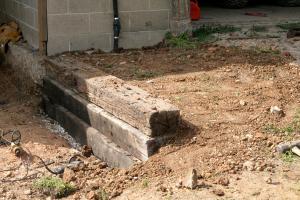Step-by-Step Guide to Building a Durable Railroad Tie Retaining Wall

-
Quick Links:
- Introduction
- Why Choose Railroad Ties?
- Materials Needed
- Design Considerations
- Step-by-Step Guide
- Maintenance Tips
- Case Studies and Examples
- Expert Insights
- FAQs
Introduction
Building a railroad tie retaining wall can be an excellent solution for both functionality and aesthetics in your landscaping. These sturdy walls not only hold back soil and prevent erosion but also add charm and rustic beauty to your outdoor space.
Why Choose Railroad Ties?
Railroad ties are a popular choice for retaining walls due to their durability and rustic appearance. They are typically made from hardwood and treated to withstand harsh conditions. Here are some compelling reasons to consider using railroad ties:
- Durability: Railroad ties can last for decades when installed and maintained properly.
- Cost-Effectiveness: They are often more affordable compared to other retaining wall materials.
- Natural Aesthetic: The natural wood grain and weathered look add a unique appeal to any landscape.
Materials Needed
Before you start, gather all the necessary materials. Here's a comprehensive list:
- Railroad ties (lengths can vary)
- Gravel (for drainage)
- Landscape fabric
- Concrete mix (optional for added stability)
- Heavy-duty nails or screws
- Shovel and digging tools
- Level
- Safety gear (gloves, goggles)
Design Considerations
Designing your retaining wall involves several considerations:
- Height: Check local regulations regarding the maximum height for retaining walls.
- Location: Choose a location that will not interfere with drainage.
- Angle: A slight backward lean (about 10-15 degrees) can enhance stability.
Step-by-Step Guide
Follow these detailed steps to construct your railroad tie retaining wall:
Step 1: Planning and Site Preparation
Begin by planning the layout of your wall. Mark the area with stakes and string to outline the wall's boundary. Make sure to measure the height and length needed.
Step 2: Digging the Trench
Excavate a trench to a depth of about 1 foot. This will help ensure stability and drainage. The width should be about twice the width of the railroad ties.
Step 3: Adding a Gravel Base
Fill the bottom of the trench with 4-6 inches of gravel to promote drainage and prevent water buildup behind the wall.
Step 4: Installing the First Layer of Ties
Lay the first layer of railroad ties in the trench, ensuring they are level. Use a level to check each tie.
Step 5: Securing the Ties
Secure the ties using heavy-duty nails or screws. If desired, you can also pour concrete around the base for added stability.
Step 6: Building Additional Layers
Repeat the process, offsetting each layer for stability. Ensure that each layer is level before proceeding to the next.
Step 7: Adding Drainage
Install landscape fabric behind the wall to filter out soil, followed by more gravel to aid drainage.
Step 8: Finishing Touches
Backfill the area behind the wall with dirt, compacting it as you go. Ensure the top of the wall is even and smooth.
Maintenance Tips
To ensure the longevity of your railroad tie retaining wall, follow these maintenance tips:
- Inspect the wall annually for signs of rot or damage.
- Reinforce areas that show signs of wear.
- Clean debris from the top of the wall to prevent moisture buildup.
Case Studies and Examples
Here are some real-world examples of successful railroad tie retaining wall projects:
Example 1: Residential Garden
A homeowner built a 3-foot-high retaining wall using reclaimed railroad ties to separate their vegetable garden from the lawn. They used a staggered pattern for added stability and aesthetics.
Example 2: Commercial Landscape
A local business used railroad ties to create a decorative border around their flower beds. The ties were treated with a protective finish, ensuring they remained visually appealing for several years.
Expert Insights
According to landscape architect Jane Doe, “Railroad ties can be a stunning addition to any landscape when installed correctly. Prioritize drainage to prevent water from pooling behind the wall, which can lead to failure.”
FAQs
1. How long do railroad ties last?
With proper maintenance, railroad ties can last up to 30 years.
2. Are railroad ties safe for garden use?
Yes, but ensure they are treated with non-toxic chemicals for garden applications.
3. How tall can I build a railroad tie retaining wall?
Most local regulations allow walls up to 4 feet tall without special permits.
4. What type of drainage should I use?
Gravel backfill and landscape fabric work well for drainage behind the wall.
5. Can I paint or stain railroad ties?
Yes, using exterior wood stain can enhance appearance and longevity.
6. How much do railroad ties cost?
The cost can vary, but expect to pay between $10 to $25 per tie, depending on size and quality.
7. Do I need a permit to build a retaining wall?
Check with local regulations, as permits may be required for taller walls.
8. How do I prevent weeds from growing in my wall?
Using landscape fabric behind the wall can help inhibit weed growth.
9. Can I use used railroad ties?
Yes, used ties can be a cost-effective solution, but inspect them for rot or damage.
10. What tools do I need to build a railroad tie retaining wall?
You’ll need a shovel, level, hammer, nails or screws, and safety gear.
Building a railroad tie retaining wall can be a rewarding project that adds both functionality and beauty to your outdoor space. Follow these steps and tips for a successful installation.